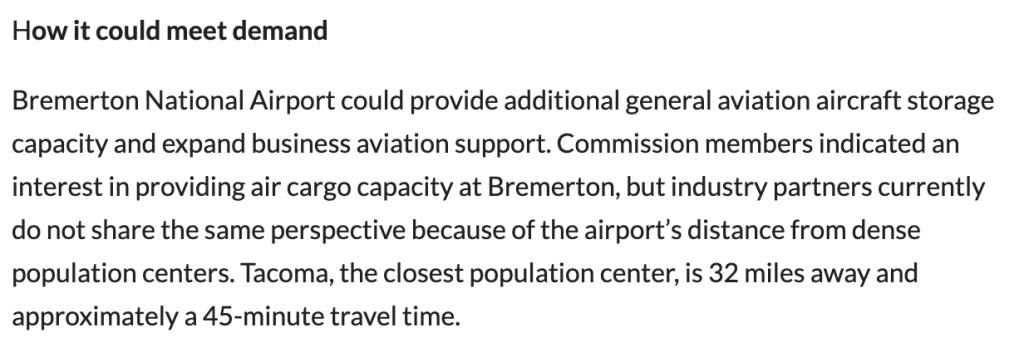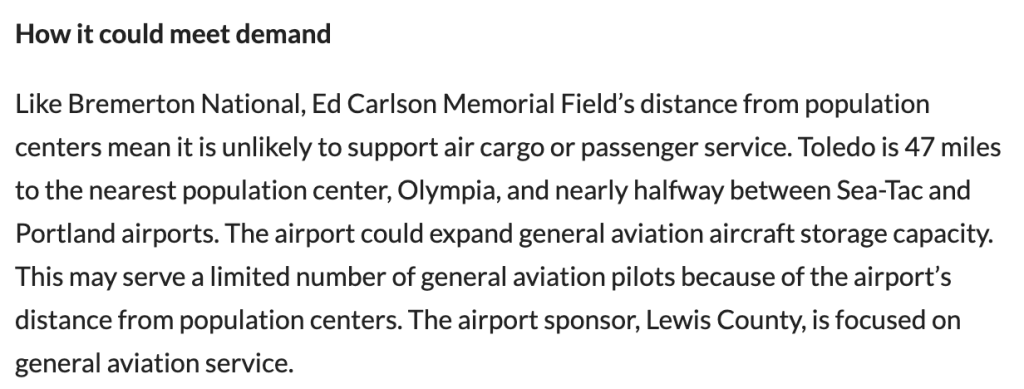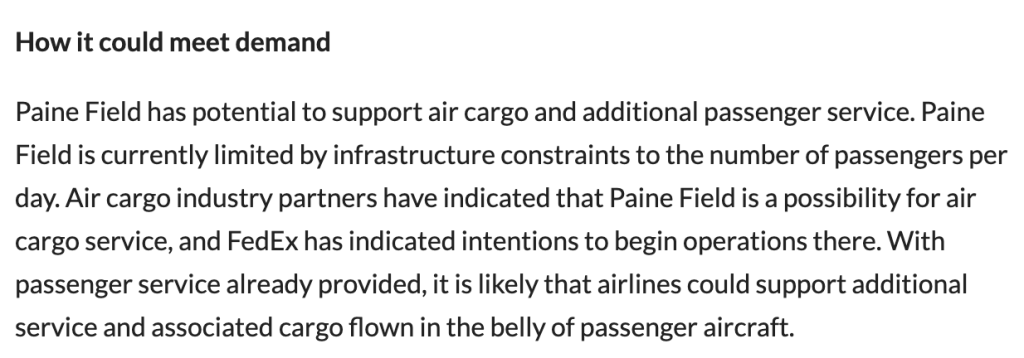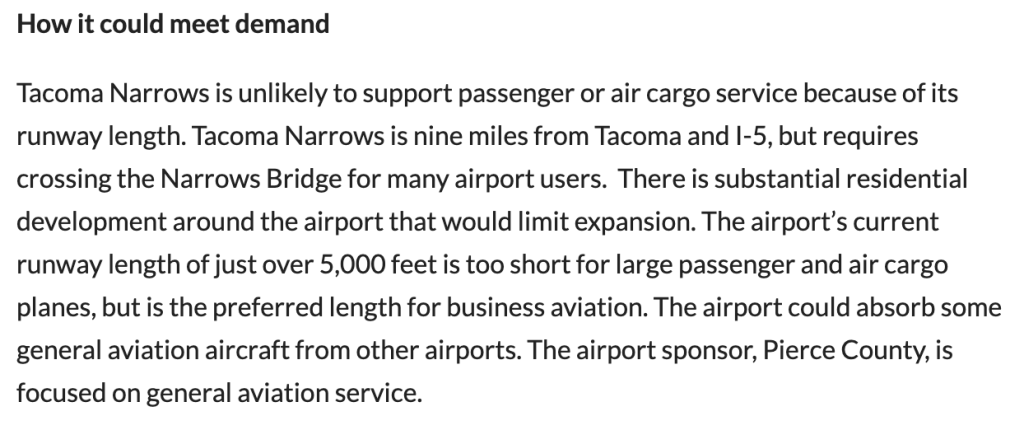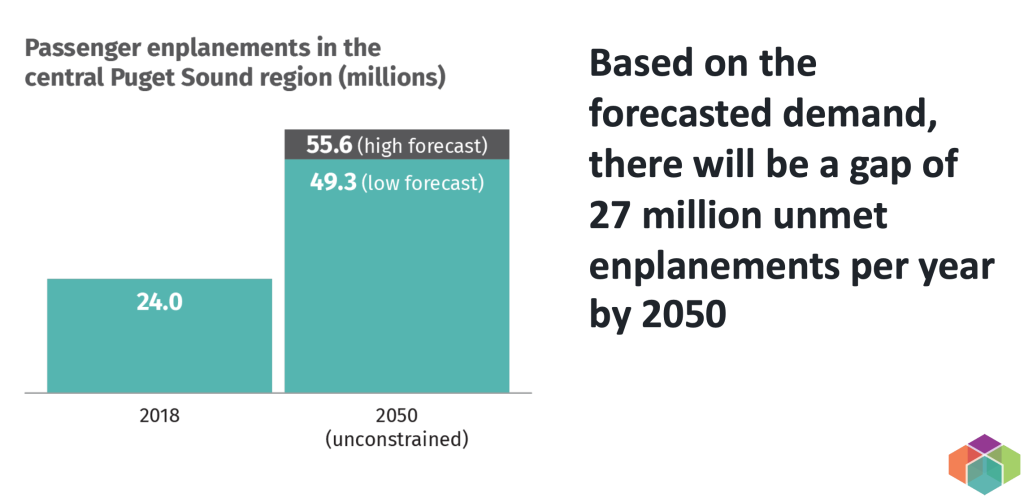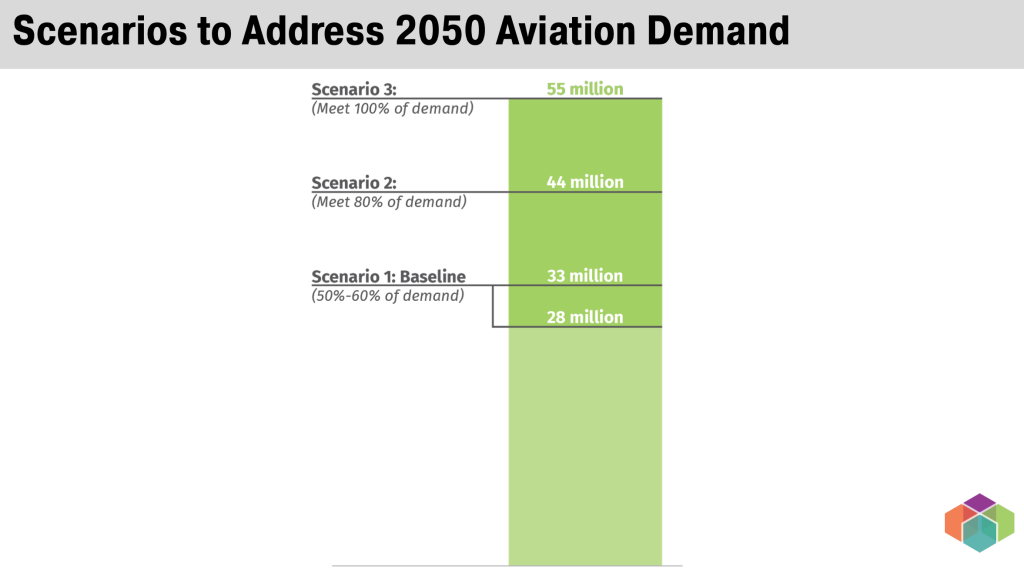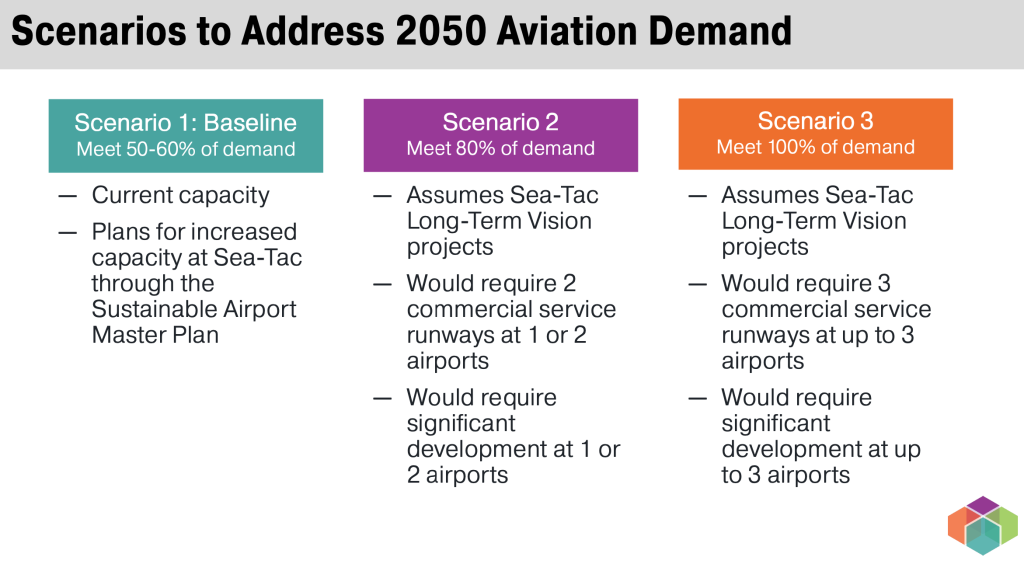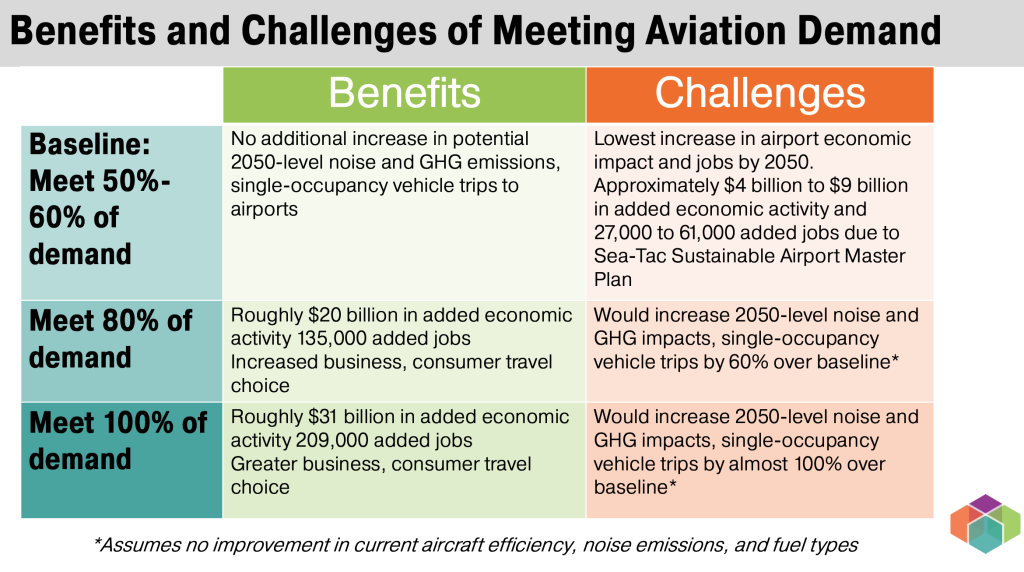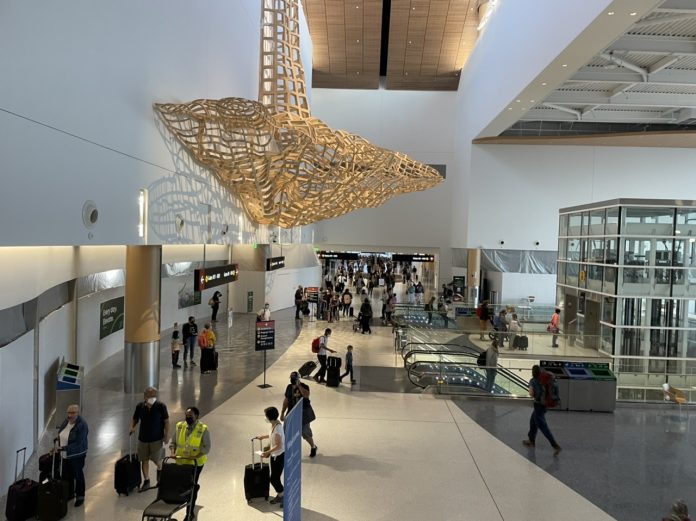
Washington is still hunting for a new major commercial airport location as part of a state-mandated study. The state department of transportation has winnowed the list down to six possible sites in Puget Sound — none of which are in King County. A somewhat similar study was conducted by the Puget Sound Regional Council (PSRC), which wrapped up in May. As part of the selection process, the state department of transportation is seeking public feedback on topics which amount to economic priorities.
Shortlisted sites by the commission
Known as the Commercial Aviation Coordinating Commission (CACC), the Washington State Legislature has tasked the commission to identify a single site for a new major commercial airport. The first phase of the effort has shortlisted six possible sites for a new airport. Among these are:
- Arlington Municipal Airport, which has one runway that is 5,332 feet long and 100 feet wide;
- Paine Field Airport (Everett), which has one runway that is 9,010 feet long and 150 feet wide;
- Bremerton National Airport, which has one runway that is 6,000 feet long and 150 feet wide;
- South Lewis County Airport (Toledo), which has one runway that is 4,479 feet long and 150 feet wide;
- Sanderson Field Airport (Shelton), which has one runway that is 5,005 feet long and 100 feet wide; and
- Tacoma Narrows Airport (Gig Harbor), which has one runway that is 5,002 feet long and 100 feet wide.
The locations of these airports would generally benefit commercial passengers in the south end of Puget Sound and out in Kitsap County and the Olympic Peninsula, with the exception of Arlington Municipal Airport and Paine Field Airport (PAE). Right now, passengers in King County and Snohomish County — and to a degree in Pierce County — have reasonable access to Seattle-Tacoma International Airport (SEA) and PAE, though SEA offers the widest selection of flights. North of Snohomish County, Puget Sounders have reasonable access to Bellingham International Airport (BLI). So, it does make sense that CACC would focus interests for a new major commercial airport south of Seattle, though it remains unclear how much larger PAE will become in the future — the airport is currently capped at 24 daily departures.
PSRC’s Regional Aviation Baseline Study findings
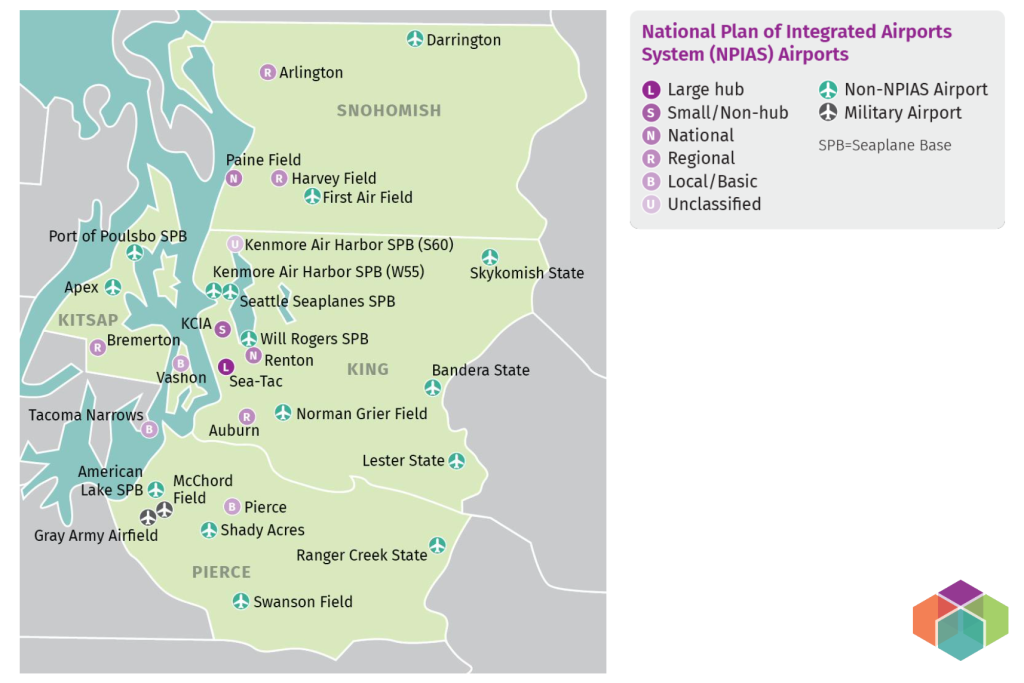
The PSRC’s Regional Aviation Baseline Study — while similar to work by the CACC — did not make recommendation on any airport expansions or siting of new airports. What it did do is take stock of existing airports — both public and private — throughout Puget Sound to determine trends, forecast growth, and evaluate future system requirements as well as operational issues like flight paths.
Generally speaking, the Regional Aviation Baseline Study found that the region will have capacity for 28.6 million annual enplanements (the number of passengers boarding flights) by 2027 and that demand will grow to 55.6 million annual enplanements by 2050. Despite growth plans at SEA, the airport wouldn’t be able to keep up with the level of demand and is poised to reach full capacity in the 2030s. The study also expressly noted that even with projected growth and expansion at SEA and PAE, the region would face an estimated unmet demand of 22 million to 27 million annual enplanements by 2050. However, the impact of Covid was not seriously analyzed and the underlying pre-Covid assumptions for commercial aviation demand were assumed by the study, with the PSRC indicating that “airports and airlines estimate a recovery to 2019 levels by 2023 to 2024.”
Air cargo growth is also surging and faces some challenges ahead. In 2017, 539,600 metric tons of air cargo were moved through the region’s airports. This is projected to grow to 1,319,300 metric tons per year by 2050. There is some seasonality for air cargo demand, but ultimately there is concern that air cargo demand may run into challenges by 2027 due to warehousing space at SEA and King County International Airport. The study points out there “there are opportunities to redesign existing on-airport facilities, develop new off-airport facilities, use Grant County Moses Lake International Airport as a cargo reliever during the harvest time for high value crops like cherries, and shift some traffic to Spokane International Airport to create additional capacity in the central Puget Sound region.”
As far as general aviation is concerned, the PSRC study suggests that “there will be adequate runway capacity to accommodate general aviation demand through 2050.” However, general aviation airports do need some investment to address issues of deteriorating runways and insufficient hangar space.
Ultimately, three scenarios were evaluated to meet 50%, 80%, and 100% of 2050 regional aviation demand. The study found that a second SEA-size airport or multiple airport investments on the same scale would be required to meet forecasted 2050 demand. Study findings also provide some consensus with CACC on site strengths for expansion on a technical basis. Of the 29 airports evaluated, four locations were analyzed more deeply, which included: Arlington Municipal Airport, Bremerton National Airport, Paine Field Airport, and Tacoma Narrows Airport. The study found that Arlington Municipal Airport, Bremerton National Airport, and Tacoma Narrows Airport all have room for expansion, and that Paine Field Airport has capacity to support more service. However, the study also found that Arlington Municipal Airport lacked significant population and employment access to commercial air service since it’s located near Paine Field Airport and that Tacoma Narrows Airport lacks much potential to extend the runway.
Commission seeking feedback on economic priorities
For public outreach the CACC’s site selection process, the the state department of transportation has developed a very narrow subset of questions that feedback is being sought. These include questions about what the “airport of the future” should look like, airport expansion priorities, and corresponding principles for recommendations. Commenters can provide much deeper thoughts on priorities, but they aren’t directly surveyed on them.
Three key options are spelled out in the survey on airport expansion:
- “Building increased aviation capacity at a new airport or existing airports to meet projected demand, which requires funding and creates certain environmental impacts.”
- “Continue operating with our current airport facilities; not meeting forecasted demand could create schedule delays for passengers and cargo, limited opportunity for economic growth tied to the aviation industry, and the potential for environmental impacts from planes waiting to land.”
- “Building increased aviation capacity to meet projected demand, but only doing so if the environmental impacts from aircraft emissions and noise can be significantly mitigated.”
The three options are curiously laid out to hide the no build option in the middle and make the no build option seem dire for the region. It assumes that there aren’t other options and that establishing a new major airport will have lower environmental impacts and better economic consequences, which are deeply flawed assumptions. In addition, the survey oddly has an entire section on the “airport of the future” to test opinions about more regional service airports and zero emissions planes, which are expected to have seriously limited capacity and benefits during the planning period of the study — which are points emphasized in the survey.
Ultimately, the outreach effort omits the contexts for urban growth, synergistic and supporting transportation, and alternative investments like freight rail and high-speed rail while heavily boxing in what the public can weigh in on. The outreach effort also seems to paper over grave environmental issues that any new airport would pose to communities.
It’s further worth emphasizing that the public comment period is very short, running only through October 3rd. Two weeks is exceedingly short for public outreach on such a critical policy planning process.
Next Steps
With all of this in mind, the CACC must deliver a final recommendation by February 15, 2023. In the interim, the body is expected to shortlist two locations by September 15, 2022. Public comment on the survey will remain open through October 3rd.
Stephen is a professional urban planner in Puget Sound with a passion for sustainable, livable, and diverse cities. He is especially interested in how policies, regulations, and programs can promote positive outcomes for communities. With stints in great cities like Bellingham and Cork, Stephen currently lives in Seattle. He primarily covers land use and transportation issues and has been with The Urbanist since 2014.


